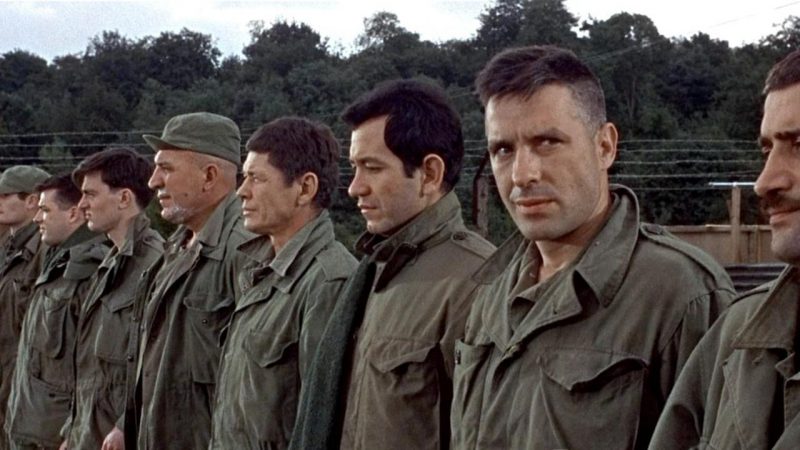E. M. Nathanson released his bestselling novel The Dirty Dozen in 1965. It later became one of the most enduring and ridiculous World War II movies made in Hollywood. The 88-year-old author died on April 5 at his home in Laguna Niguel, CA. Elizabeth Henderson, his wife, confirmed that he passed away.
Mr. Nathanson was a New Yorker who packed up and moved to Los Angeles in the mid-1950s, where he found work as a writer for a military magazine. Russ Meyer was his neighbor in Hollywood Hills. Meyer shared with Nathanson a nugget of a story that ultimately manifested in his first novel.
During World War II, Meyer was a combat photographer and cinematographer. He recounted an episode at an Army stockade in England where he photographed a company of prisoners in training. Supposedly, they were preparing for a top-secret mission to take place behind enemy lines just before D-Day.
Nathanson took this as an opportunity to conduct his own research on what he imagined would become a nonfiction book about the company. He was unable to confirm that the company even existed, but did uncover a trove of information in court martial transcripts and other documents about the men in Army stockades during World War II.
This helped him create the characters in the novel that he titled The Dirty Dozen (making reference to a collective refusal by all the men to bathe or shave for the duration of their training).
This company depicted in the novel looks a lot like a group called the Filthy 13, a band of rambunctious authority-defying paratroopers more known for partying than washing. They were in and out of the stockade, and they landed behind German lines before the D-Day invasion at Normandy. However, Nathanson portrays his distasteful soldiers as murderers and borderline madmen. He claimed his book was based on Meyer’s initial tale coupled with his own imagination.
The Kirkus Reviews described the book as powerfully prosaic. There were about 2 million copies of The Dirty Dozen sold. Robert Aldrich directed the movie based on the novel, which came out in 1967, and it became a pop culture landmark. A long list of Hollywood stars was cast, including Lee Marvin, Ernest Borgnine, and Robert Ryan. Trini Lopez (a pop singer), Jim Brown (an athlete who switched careers to show business) and other actors who were becoming or would become big names were also cast. The film also featured Donald Sutherland, John Cassavetes, Telly Savalas, George Kennedy and Charles Bronson.
The enticing plot portrayed the company major as a military authority and a strict disciplinarian who always stood up for every man under his command. The criminals and the eccentric psychopaths end up being heroes when they successfully blow up their target (a luxurious rest house for German officers).
The movie received four Oscar nominations, and it was number 65 on a list of the “100 most thrilling American films” compiled by the American Film Institute.
Erwin Nathanson was born on February 17, 1928, in the Bronx. His father was a laborer, and his mother, Ruth Goldberg, suffered from depression. She was admitted into an institution, which led to Erwin being placed in a Jewish orphanage in Manhattan at the age of two. He remained in the orphanage until he was seven, when he was sent to the Hebrew National Orphan Home in Yonkers. He lived there until he graduated from high school.
Early on, Nathanson had hopes of being a journalist and worked as a copy boy for Women’s Wear Daily. Then he was a stringer for the Washington Post but moved to Los Angeles in 1956. He published several novels in addition to The Dirty Dozen. Dirty Distant War was released in 1987, a sequel of sorts that was set in Asia and followed the same Office of Strategic Services officer who organized the Dirty Dozen company. He finds himself in French Indochina fighting amongst local guerrillas rebelling against the Japanese.
His other books are The Latecomers (1970), whose protagonist has psychological issues and a religious obsession; a first-person novel about a bad marriage that ends in murder called It Gave Everybody Something to Do (with Louise Thoresen) in 1974; Knight’s Cross (with Aaron Bank) about German POWs who turn traitor (1993); and Lovers and Schemers (2003), a fictionalized version of coastal Southern California from the 1960s to the 1990s.
Nathanson’s first marriage did not last. He remarried in 1985 to Elizabeth Henderson, who survives him, along with a half-brother Donald Nathanson, a son Michael, and two daughters, Larisa and Adriana.
His nickname was Mick (hence the M in E. M.). In an article describing his time in the orphanage, he elaborated on how that nickname came to be. “I was nicknamed ‘Mike’ by my father. At the home, I was nicknamed ‘Mickey.’ Once I had a girlfriend, more than 50 years ago, who liked ‘Mick’ better, and so did I, so that’s who I became.”
